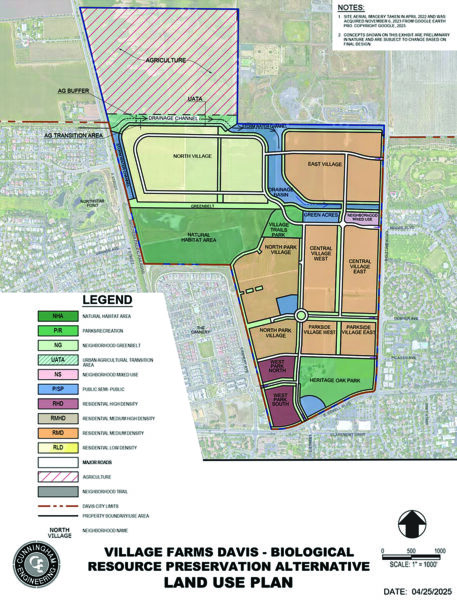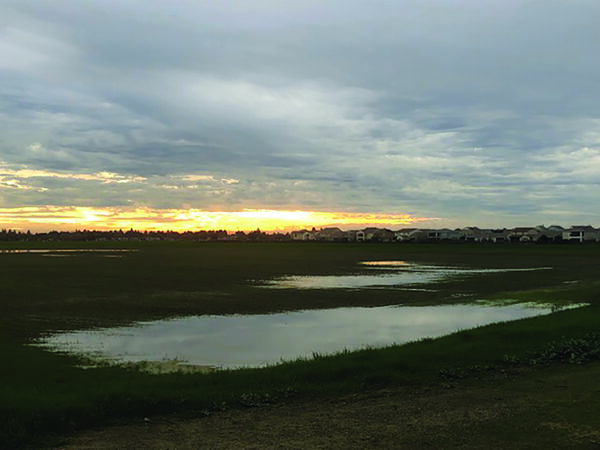As the City of Davis continues to face a housing shortage, the largest proposed housing development—Village Farms, with 1,800 homes on 390 acres at Pole Line and Covell—is now slated for the June 2026 ballot instead of a vote this year. The Measure J vote is high-stakes, as Davis voters have historically rejected most proposals. This Op-Ed explores possibilities of what Village Farms could be from an ecological justice and Yolo Just Transition perspective.

By: Juliette Beck, climate justice advocate & co-founder of YoloSol
Imagine Village Gardens
Next June, the people of Davis are scheduled to vote on the largest housing development in the city’s history: Village Farms. The project developers propose to enclose and rezone nearly 500 acres of Yolo County farmland in order to build five new neighborhoods with more than 1,800 homes.
My family has lived next to the proposed project site for the past sixteen years. Every morning, I observe the seasonal changes to the land. I think about the world our children are inheriting. I wonder what this pivotal moment in history is asking of us?
I often reflect on what I’m learning from Native people such as my dear friend Diana Almendariz, a practitioner of Wintun/Maidu culture, heritage and experiences whose ancestors tended and cared for this valley for thousands of years.
The City of Davis is also initiating an update of its General Plan. Preparation of the plan’s environmental justice element needs an open conversation about the racialized, colonial legacy of entitlement, land theft and exploitation at the root of the climate crisis.
How we work together to repair and transform the dominant culture of removing native plants that permeates the modern worldview will certainly put our humanity to the test. Perhaps the telling of a more truthful history of the land is a good place to start this critical conversation.
The Village Farms Draft Environmental Impact Report (DEIR) glosses over the apocalypse Native people experienced during the Gold Rush, as California became a state: “After European contact, the Sacramento Valley floor was transformed into a mosaic of irrigated agriculture, wetlands, and riparian habitats.”
This rosy narrative erases the catastrophic cultural and ecological loss that Native communities experienced. What Euro-Americans “discovered” when they came to this region in the 1800’s, was an incredibly productive, interdependent network of garden ecosystems cultivated by Native people with methods–such as cultural burning–that enhanced biodiversity and sustained their lifeways for millennia.
Prior to the mass influx of settlers, Native communities maintained a lush riparian forest along Putah Creek.. Abundant wetlands teemed with invertebrate life that formed the basis for a rich food web. Vast grasslandsmanaged using fire sustained large herds of pronghorn antelope, tule elk, and deer. The skies of the Pacific Flyway were filled with multitudes of migratory birds.
A seasonal creek once flowed across the southern part of the land now slated for the Village Farms development. Flakes of obsidian and a biface tool fragment found on site during archeological surveys indicate that Native people actively used this land, perhaps as a village site, acorn harvesting area, or seasonal hunting camp.
In 1848, the Mexican Governor Pío Pico purportedly “gifted” the land comprising Davis and its environs to Victor Prudon and Marcos Vaca. This Rancho Laguna de Santo Calle land grant was later deemed fraudulent, but not before Vaca and Prudon sold the Davis portion to Joseph Chiles in 1850. Chiles, in turn, gave land to his son-in-law, Jerome Davis, who established the town of Davisville in 1868 when it became a depot on the Southern Pacific Railroad.
The Village Farms DEIR omits much of this history but infers early American settlers likely used the federal Swamp and Overflowed Land Act of 1850 to drain and claim the land for Western agriculture. Once cleared of Native habitat and Native people, the land has been used by various owners to grow commodities such as wheat, corn and tomatoes.
My grandfather, great-grandfather and great-great grandfather all played a heavy hand in re-inengineering the Sacramento Valley to advance settler agriculture. I now know that this industrial agricultural system has grown at the expense of food sovereignty—access to traditional foods—for Native communities. This loss contributes to an ongoing public health crisis for Native people who have a significantly lower life expectancy and are twice as likely to die of diabetes than people of European ancestry. The City of Davis could begin to address this disparity by requiring developers to work with Native cultural practitioners to restore Native food pathways.
Village Farms developers propose to set aside land for greenbelts and parks. These are areas that could be reimagined as places to restore Native stewardship practices and paradigms in partnership with Native people. The seasonal creek bed could be surfaced and restored. Tule and cattail marshes could be created to filter greywater and provide natural cooling systems. Restoring healthy Native aquatic invertebrate life would have the added benefit of keeping invasive mosquitoes that breed diseases like West Nile virus and Dengue fever at bay.
Material Reparations for Native People
Until the 1950s, restrictive housing covenants specifically excluded people of color from owning homes in Davis. Native people continue to lack access to affordable housing and safe places to practice their land-based culture.
While the State of California considers different forms of reparations including the return of traditional hunting, fishing and gathering areas and allowing universities to waive tuition costs for Native students, local communities are also engaging in meaningful ways with Native people to remedy past and persistent harm. A number of East Bay cities are encouraging residents to voluntarily pay Shuumi land tax to the Sogorea Te’ Indigenous women-led land trust working to “rematriate” land by restoring land access and supporting cultural revitalization for Ohlone people.
Housing developments such as Village Farms could also be an opportunity to address persistent racial disparities, starting with prioritizing housing for Native people.
The Village Farms developers have proposed a “Demonstration Farm” for local high school students. Perhaps, instead of or in addition, developers could work with Native community members to create a cultural center dedicated to the regeneration of traditional ecological knowledge: a place for reflection, healing, repair, innovation and renewal.
Adapting to a rapidly-changing climate requires a different way of relating to the world around us. Humans have an important role to play in caring for climate-resilient ecosystems. The City of Davis should promote universal access to garden space and natural areas for intergenerational stewardship. Greening the landscape with Native plants will also make neighborhoods more resilient to extreme heat.
Housing should be constructed to minimize ecological footprints, discourage toxic chemical use, and maximize sharing and interdependence. Projects could include a variety of environmentally-conscious housing options including tiny homes and cooperatively-owned housing.
Cooperatively-owned and managed housing embodies the Just Transition principle of direct democracy and has a proven track record of maintaining affordable, community-centered housing over time. The Dos Pinos limited equity, nonprofit cooperative housing community is a good example. Built in 1985 on just four acres in North Davis, Dos Pinos has a shared kitchen, community center, swimming pool and green space. Decisions are made by a seven-member board elected by the residents of sixty affordable housing units.
In addition to prioritizing housing for Native people, cooperative housing could provide housing for people from historically marginalized groups, artists, community organizers, and low-income families priced out of the Davis housing market.
Imagine intentional cohousing communities focused on restoring ecological balance and healthy relationships through an ethic of reciprocity: sharing, reusing, recycling and caring for the Yolo web of life.
Village Gardens?
Western society has reached a fork in the road. We can ignore symptoms—or we can acknowledge the long history of harmful development patterns, seek to heal and repair the damage to the land and her original stewards, and change course towards an ecologically regenerative, equitable future.
In this time of great uncertainty, how we relate to and inhabit land is critical to the wellbeing of future generations. With training and guidance from Native homeland people, perhaps future residents will be engaged in repairing and tending a living, thriving tapestry of Village Gardens. Which path will we choose?




